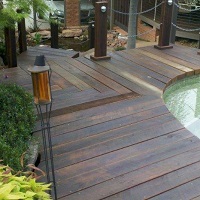
A 4-foot-high, 15-foot-long wall could be holding back as much as 20 tons of saturated soil. That’s because most residential retaining walls have poor drainage, and many aren’t built to handle the hillside they’re supposed to hold back.Įven small retaining walls have to contain enormous loads. Common Problems: Drainage, Weight of SoilĪlthough retaining walls are simple structures, a casual check around your neighborhood will reveal lots of existing walls that are bulging, cracked, or leaning. We also review the four most common types below: timber, interlocking blocks, stacked stone, brick or block, and concrete.
#LANDSCAPE LUMBER HOW TO#
If your property needs a retaining wall, or if the one you have is failing, follow our guide on how to build a retaining wall or hire a pro. These handsome barriers also make inviting spots to sit, and can increase usable yard space by terracing sloped properties, something that is increasingly important as flat home sites become ever more scarce in many regions.Īlong with sloped landscapes where water runoff causes hillside erosion, ideal locations for a retaining wall system include spots downhill from soil fault lines and where the downhill side of a foundation is losing supporting soil or its uphill side is under pressure from sliding soil. They restrain tons of saturated soil that would otherwise slump and slide away from a foundation or damage the surrounding landscape. But in fact, they’re carefully engineered systems that wage an ongoing battle with gravity. Then what warps while stickered, gets returned for credit.Sure, retaining walls look like simple stacked stone, block, or timber. I sticker stack all lumber I get from a yard right away, to let it equalize before using it. But it is all built into the price we pay for treated material, so the lumber yard doesn't care, as they pass the cost on to the consumer. Then the remaining top wet boards start to dry and warp, and get tossed aside when the next customer arrives. The treated-wood buying public pick through the top warped boards, to get to the wet, straight ones below. I've long felt it would be a paying thing if lumber-yards would sticker their incoming treated lumber, and avoid the waste that they get now. In addition, I pulled out all the heartwood radius-edged boards and sent them back to the yard. When time came to lay those boards, all went very well. I followed DanG's advice when having a deck built several years ago, and had the deck boards delivered a couple months in advance. Those were used to make a temporary fence for the goats we don't have anymore, and I'm going to tear it down soon, so I'll see how they held up. The landscape timbers I have bought.last ones were about 5 years ago.always said. 40 and their tags state that it is ok for ground contact. 4x and larger is almost always treated to. 25 and the tags plainly state that it isn't for ground contact. I've been reading tags for a long time, and here's what I've seen in the past: 1x and 2x lumber is almost always treated to. I sure do see a lot of crappy looking decks around. Hardly anybody wakes up one morning and decides to build a deck that day, but most wait until time to start building to get their lumber. If ya want a good project, have the lumberyard open a fresh bundle and only take the stuff from the inside, then stack/sticker like you would lumber from your mill. The top will dry faster than the bottom and it will try to curl up. Same goes if you nail it onto a deck while it is wet.

If you take the finest of lumber, soak it through with water, then dead-stack it in the sun, it will move a lot. It is made that way by poor handling after it leaves the plant. Y'all check around your lumberyards and BB stores when you're there and do a little tag reading, OK? The Better Business Bureau could very easily get involved here. 40? If he don't know, I'll ask him to read the tag to me. Whaddaya bet they answer "yes"? If so, I'm gonna ask what strength they're treated to. I'm going to call HD tomorrow and ask if they have any pressure treated landscape timbers. These were produced by Great Southern Woods in Georgia, the "Yellawood" folks.



I checked the sign by them and it does not say that they are pressure treated, though they look for all the world like they are. Today, I stopped by Home Depot where they were purchased, and they still have them out there for sale. I had to get a magnifying glass to read the blurry fine print where it say's that they are "surface coated" with ACQ, and NOT pressure treated. I noticed that they didn't seem to have any green color on the inside, not even around the edges, so I fished one of the little tags out of the trash and tried to read it. I didn't want to do it, but he's a good friend, so I did. Last week a friend brought over a couple of newly purchased landscape timbers and asked me to rip them for him on the table saw.


 0 kommentar(er)
0 kommentar(er)
